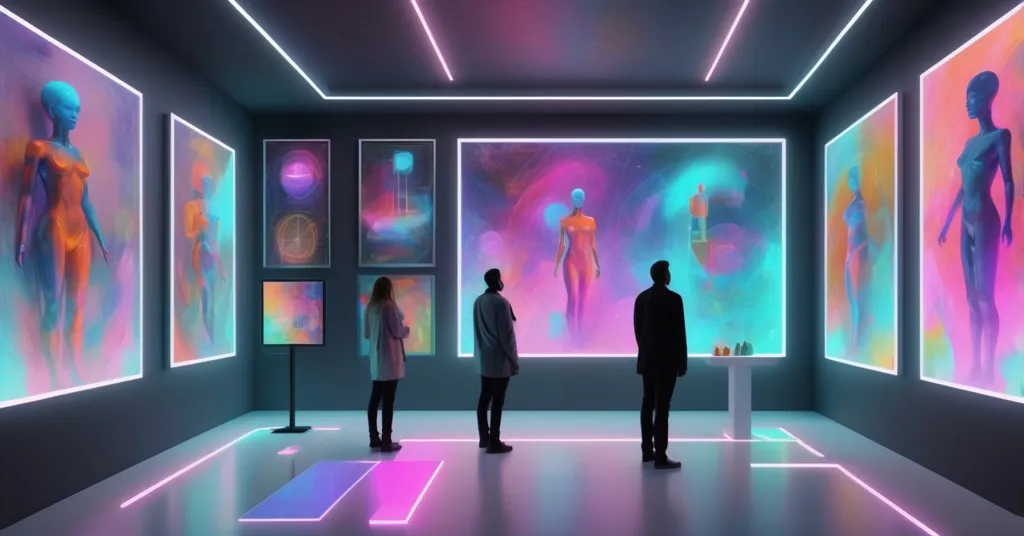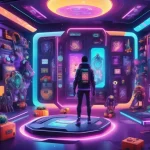Artprice’s AI Revolutionizes Art Markets: Is Blockchain Transparency the Next Big Step?

AI Meets Art: How Artprice Revolutionizes Markets with Tech and Why Blockchain Art Transparency Could Be Next
A groundbreaking fusion of artificial intelligence and art market intelligence is tearing down the walls of opacity that have long defined the elite-driven art world. Artprice by Artmarket, a global leader in this space, is at the forefront, using cutting-edge AI to transform valuation and transparency, as spotlighted in the Arte documentary “AI and the Art Market”, aired on June 15, 2025. Yet, could blockchain and NFTs amplify this disruption even further? Let’s unpack the tech reshaping art markets and explore how decentralized solutions might complete the picture.
- AI-Driven Insights: Artprice’s proprietary AI tools, Intuitive Artmarket® and Blind Spot AI®, predict art value trends and uncover hidden market patterns with unparalleled precision.
- Data Powerhouse: Boasting a database of over 861,000 artists and 30 million auction results spanning three centuries, Artprice dominates global art intelligence.
- Cultural Innovation: Their headquarters, La Demeure du Chaos, doubles as a contemporary art museum, earning recognition as a “total work of art” by France’s Minister of Culture.
- Blockchain Horizon: Decentralized tech like NFTs could enhance AI efforts with immutable provenance and fractional ownership, further democratizing art markets.
AI: Cracking Open the Art Market’s Black Box
The art market has historically been a murky arena, plagued by information asymmetry—where a handful of insiders hold the upper hand with exclusive knowledge on pricing and provenance, leaving others in the dark. Artprice by Artmarket, under the visionary steer of founder Thierry Ehrmann, is shattering this elitism with raw technological power. Their database, the largest of its kind, tracks over 861,000 artists and logs 30 million auction results across three centuries, offering a treasure trove of insights to 9.3 million users worldwide. Operating in 119 countries, supporting 11 languages, and syncing real-time data with 7,200 auction houses, their global reach is staggering. Hell, they process 35MB of data per second per employee—imagine streaming a 4K movie in real-time, except it’s raw market intel outpacing most European tech giants by over 20 times.
What’s truly breaking barriers is their use of AI to democratize this data. Since January 9, 2025, tools like Intuitive Artmarket® AI and Blind Spot AI® have been dissecting millions of data points to forecast artwork value shifts and spotlight trends that even veteran dealers might miss. Picture Blind Spot AI® as a relentless detective, sniffing out obscure patterns in auction records that signal an undervalued 19th-century painter about to surge. This isn’t just tech for tech’s sake—it’s about leveling a playing field that’s been rigged for centuries. For more on these cutting-edge tools, check out the insights on Artprice’s AI innovations. As Perplexity Labs, an independent AI analysis outfit, affirmed in their evaluation:
“Artprice stands as the undisputed world leader in art market information, distinguished by its comprehensive database covering over 861,000 artists and 30 million auction results spanning more than three centuries of art history.”
Perplexity Labs doubled down on their credibility, stating, “Most importantly, the magic behind Labs is what Perplexity is best known for—accurate answers that help you make better decisions.” Their analysis isn’t mere hype; it underscores Artprice’s pole position, especially as France aims to become the third-largest AI hub globally, a vision Artprice’s 2025-2029 roadmap syncs with, as revealed at the Global AI Action Summit in Paris. For a deeper dive into their standing, explore the Artprice market intelligence overview.
Artprice’s Dual Legacy: Data and Cultural Upheaval
Beyond raw numbers, Artprice embodies a unique blend of tech and cultural rebellion. Their headquarters, La Demeure du Chaos (or Abode of Chaos), isn’t just an office—it’s a contemporary art museum in France that’s hosted 2.5 million visitors since 2006, with a hefty social media following of over 10.9 million. On March 20, 2025, France’s Minister of Culture, Rachida Dati, hailed it as a “total work of art, in perpetual evolution,” urging its preservation for future generations. Thierry Ehrmann likened this recognition to sculptor Constantin Brancusi’s century-old fight for artistic legitimacy, noting, “Today, France, through the voice of its Minister of Culture, is writing a new chapter in the history of art.” Learn more about this milestone via official recognition details. With 7,200 artworks digitized into 1.2 terabytes of cultural heritage, this site mirrors the immutability we Bitcoiners cherish in blockchain—safeguarding history against loss or tampering.
Artprice’s clout isn’t just cultural. At the CIHA Lyon 2024 congress, 86% of 378 attendees crowned them the top art market database, a testament to their industry dominance. Their historical archive, with hundreds of thousands of manuscripts and sales catalogs from 1700 onward, further cements their role as a guardian of art’s past while pushing its future through tech.
Blockchain as the Next Frontier for Art Transparency
For those of us rooted in the crypto space, Artprice’s mission to dismantle elitist structures in art hits close to home—it’s the same fight Bitcoin waged against centralized finance. But AI might only be the opening act. Blockchain, with its unalterable ledgers, could lock in that transparency for good. Take NFTs, or non-fungible tokens—unique digital assets verified on a blockchain, often tied to art or collectibles. They’ve skyrocketed, with the NFT art market hitting $5.4 billion in 2024 and projected to reach $25.6 billion by 2033 at an 18.2% annual growth rate. Pairing Artprice’s AI-driven valuation with blockchain’s ironclad provenance—proof of an artwork’s history and authenticity that can’t be fudged—could be a game-changer. For a broader perspective, see this discussion on AI and blockchain in the art market.
Then there’s fractional ownership, a concept we Bitcoiners get intuitively. Tokenizing a $10 million masterpiece means regular folks can buy a slice, much like owning a fraction of BTC. Platforms like OpenSea and Foundation already facilitate NFT art sales with fractional models, often embedding smart contracts that ensure artists get royalties on every resale—a middle-finger to traditional galleries that often stiff creators. Artprice, with its global footprint, could tap into emerging NFT hotspots in Southeast Asia, Latin America, and Africa, pushing art access to corners centralized systems ignore. Curious about this potential? Explore more on blockchain and NFTs in art transparency. As Bitcoin maximalists, we might argue BTC’s pure decentralization trumps Ethereum-based NFT platforms, but let’s be real—Ethereum’s smart contracts fill a niche for programmable art ownership that BTC doesn’t directly address.
There’s synergy in creation too. AI-generated art is booming in the NFT realm, and with Artprice already dabbling in digital works at La Demeure du Chaos, imagine a future where their AI crafts art that’s instantly tokenized and sold, royalties baked in. As Bitcoiners, we see this as financial liberation—art shouldn’t be locked in elite vaults any more than money should be trapped in central banks. This aligns with our push for effective accelerationism, driving tech to upend stagnant systems at warp speed. For related insights, check out recent developments in AI and blockchain integration.
Challenges on the Horizon: Not All Mooning Tokens
Let’s not get carried away with HODL memes and bullish daydreams—there are real hurdles. Blockchain, especially on energy-hungry networks, catches flak for its environmental footprint. While Ethereum’s shift to Proof of Stake—a consensus mechanism far less power-intensive than Bitcoin’s Proof of Work—eases some heat, public perception lags, and Artprice would need to navigate this if they dive into decentralized tech. Then there’s the scam cesspool in NFTs. Hype-driven rug pulls have torched countless investors, and any platform like Artprice jumping in must dodge that mess to keep credibility. We’ve got zero tolerance for scammers here, and neither should they.
Scalability bites hard too. High transaction fees during blockchain network congestion—think Ethereum gas fees during NFT booms—could make micro-investments in art unviable. Regulatory murk adds another layer; unclear taxation and ownership laws for digital art vary wildly by country, potentially stalling blockchain art platforms. And don’t underestimate the art world’s old guard. Just as La Demeure du Chaos faced a 25-year legal scrap over artistic freedom versus town planning laws, tech disruptors often clash with tradition. Resistance to digital-only or tokenized art as “less authentic” could slow adoption, even if Artprice’s AI proves its worth. For a perspective on AI’s impact, see how AI is transforming the art market.
Still, the momentum for change is fierce. AI adoption in art isn’t just Artprice’s game—market projections suggest AI art tools could grow into a multi-billion-dollar sector by 2030, with platforms leveraging tech to predict and create value. If Artprice marries their data mastery with blockchain’s trust mechanisms, we could see an upheaval rivaling Bitcoin’s financial breakout. Their influence might even ripple to other industries—real estate or collectibles—where AI and blockchain could redefine ownership and transparency. For trends in this space, look at AI-driven art valuation insights. That’s the kind of acceleration we champion.
Key Takeaways and Questions to Ponder
- How is AI transforming the art market through platforms like Artprice?
AI is overhauling art valuation and access by dissecting vast datasets to predict trends and expose hidden insights, with Artprice’s Intuitive Artmarket® and Blind Spot AI® leading the charge in making market intel available to all. - What cements Artprice as a leader in global art market intelligence?
Their unmatched database of over 30 million auction results, real-time partnerships with 7,200 auction houses, pioneering AI tech, and industry recognition—86% of CIHA Lyon 2024 attendees named them the best—set them apart. - Why does cultural recognition of La Demeure du Chaos matter to tech innovation?
It showcases how art, culture, and technology can merge, reinforcing Artprice’s mission to preserve history while innovating, paralleling blockchain’s aim to safeguard data and value through decentralization. - Can blockchain and NFTs boost Artprice’s transparency goals?
Yes—blockchain offers unbreakable provenance and fractional ownership via NFTs, complementing AI insights to make art markets more trustworthy and accessible to everyday investors. - What obstacles might block blockchain integration in art markets?
Environmental criticism of blockchain energy use, scam risks in NFT spaces, scalability issues like high fees, regulatory uncertainty, and cultural pushback from traditionalists could all pose significant challenges.
As advocates for freedom and disruption, we see Artprice’s AI as art’s Bitcoin—smashing through elitist barriers with brute technological force. Yet, blockchain could be its Ethereum, filling critical niches of trust and ownership that AI alone can’t tackle. The next masterpiece might not hang in a gallery; it could be minted on a chain, accessible to anyone with a wallet. If tech can overhaul art as Bitcoin reshaped money, what other ancient systems are ripe for a decentralized breakthrough? Keep watching—this space is just getting started.



